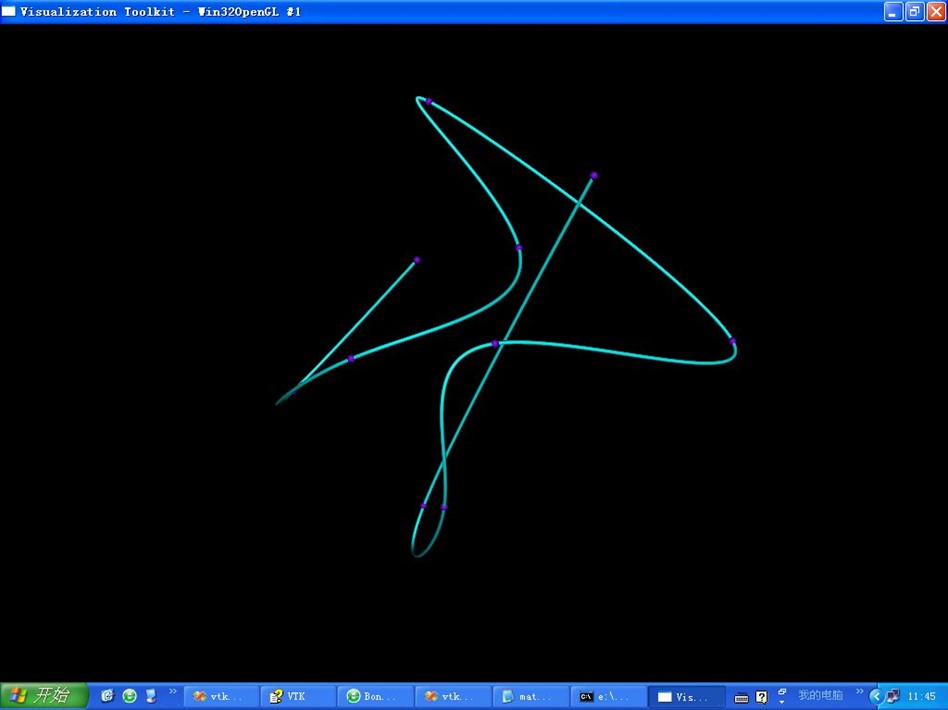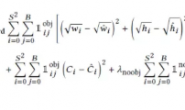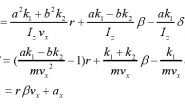/*# This example demonstrates the use of tkCardinalSpline.
# It creates random points and connects them with a spline#
# First we include the VTK Tcl packages which will make available # all of the vtk commands to Tcl
package require vtk
package require vtkinteraction
package require vtktesting
# This will be used later to get random numbers.
vtkMath math
# Total number of points.*/
int numberOfInputPoints= 10;
//# One spline for each direction.
vtkCardinalSpline *aSplineX=vtkCardinalSpline::New();
vtkCardinalSpline *aSplineY=vtkCardinalSpline::New();
vtkCardinalSpline *aSplineZ=vtkCardinalSpline::New();
/*# Generate random (pivot) points and add the corresponding
# coordinates to the splines.
# aSplineX will interpolate the x values of the points
# aSplineY will interpolate the y values of the points
# aSplineZ will interpolate the z values of the points*/
vtkPoints* inputPoints=vtkPoints::New();
for (int i=0;i < numberOfInputPoints, i++)
{ x= vtkmath:: Random ();
y= vtkmath:: Random ();
z= vtkmath:: Random();
aSplineX ->AddPoint (i ,x);
aSplineY ->AddPoint (i ,y);
aSplineZ ->AddPoint (i ,z);
inputPoints ->InsertPoint (i,x ,y,z);
}
/*# The following section will create glyphs for the pivot points
# in order to make the effect of the spline more clear.
# Create a polydata to be glyphed.*/
vtkPolyData* inputData=vtkPolyData::New();
inputData->SetPoints( inputPoints);
//# Use sphere as glyph source.
vtkSphereSource *balls=vtkSphereSource::New();
balls->SetRadius( .01);
balls-> SetPhiResolution( 10);
balls ->SetThetaResolution (10);
vtkGlyph3D *glyphPoints=vtkGlyph3D::New();
glyphPoints-> SetInput (inputData);
glyphPoints-> SetSource (balls ->GetOutput());
vtkPolyDataMapper* glyphMapper=vtkPolyDataMapper::New();
glyphMapper ->SetInputConnection([glyphPoints-> GetOutputPort());
vtkActor* glyph=vtkActor::New();
glyph ->SetMapper( glyphMapper);
glyph-> GetProperty()->SetDiffuseColor(tomato);
glyph->GetProperty()->SetSpecular( .3);
glyph ->GetProperty()-> SetSpecularPower (30);
//# Generate the polyline for the spline.
vtkPoints* points=vtkPoints::New();
vtkPolyData* profileData=vtkPolyData::New();
//# Number of points on the spline
numberOfOutputPoints= 400;
//# Interpolate x, y and z by using the three spline filters and# create new points
for(int i= 0;i< numberOfOutputPoints;i++)
{
expr=( numberOfInputPoints – 1.0 ) / ( numberOfOutputPoints – 1.0 ) * i;
points-> InsertPoint (i, [aSplineX-> Evaluate() $t] ,[aSplineY-> Evaluate ()$t] ,[aSplineZ ->Evaluate() $t]);
}
//# Create the polyline.
vtkCellArray* lines=vtkCellArray::New();
lines-> InsertNextCell (numberOfOutputPoints);
for (int i= 0;i < numberOfOutputPoints;i++)
{
lines->InsertCellPoint (i);
}
profileData-> SetPoints( points);
profileData->SetLines (lines);
//# Add thickness to the resulting line.
vtkTubeFilter *profileTubes=vtkTubeFilter::New();
profileTubes ->SetNumberOfSides (8);
profileTubes-> SetInput (profileData);
profileTubes-> SetRadius (.005);
vtkPolyDataMapper* profileMapper=vtkPolyDataMapper::New();
profileMapper-> SetInputConnection (profileTubes ->GetOutputPort());
vtkActor* profile=vtkActor::New();
profile ->SetMapper (profileMapper);
profile-> GetProperty()-> SetDiffuseColor(0,1,1);
profile->GetProperty()->SetSpecular( .3);
profile-> GetProperty()-> SetSpecularPower( 30);
//# Now create the RenderWindow, Renderer and Interactor
vtkRenderer *ren1=vtkRenderer::New();
vtkRenderWindow* renWin=vtkRenderWindow::New();
renWin ->AddRenderer (ren1);
vtkRenderWindowInteractor* iren=vtkRenderWindowInteractor::New();
iren ->SetRenderWindow (renWin);
//# Add the actors
ren1 ->AddActor (glyph);
ren1 ->AddActor( profile);
renWin ->SetSize (500 ,500);
//# render the image
iren->Initialize();
//iren AddObserver UserEvent {wm deiconify .vtkInteract}
//# prevent the tk window from showing up
//wm withdraw .

转载请注明:徐自远的乱七八糟小站 » 【转贴】spline



